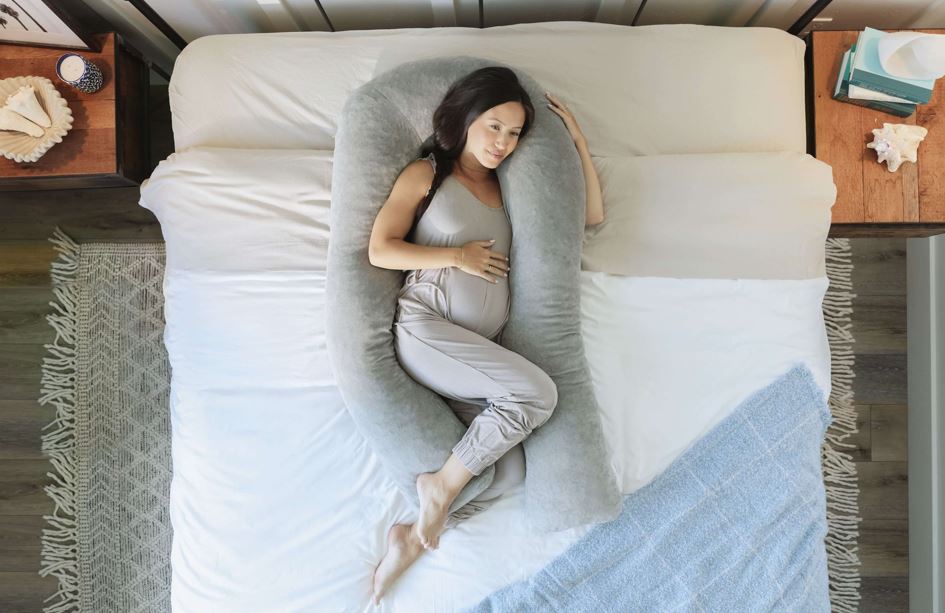Sleep should recharge you, yet pregnancy can make nights tricky. Your center of gravity shifts. Hips carry more load. Muscles try to keep up, and your lower back often pays the price. The good news is that simple tools can change the way you rest.
A long, well-placed body pillow can guide your body into a calm, steady position. That means less strain and more deep sleep. In the next few minutes, you will learn how to use one pillow to support your belly, protect your hips, and ease the pull on your spine.
I’ve also written this article for other reasons like showing you how to pick the right shape, set it up by trimester, and avoid common mistakes. Small steps add up to real relief, and that’s something to keep in mind.
Why back pain shows up in pregnancy
Your body shifts to make room for a growing baby. There’s no bigger change or discomfort than when a pregnant mother goes through these changes. So, what can be done? A body pillow for pregnancy cushions your belly, hips, and lower back so those changes feel softer.
As weight moves forward, the curve in your lower spine can deepen and joints can feel sore. Hormones loosen ligaments. Posture can change during the day, then follow you into sleep. Side sleeping is helpful, but only when your body stays lined up.
How a body pillow eases strain
The body pillow is more than cozy. It works like a gentle guide that keeps you in a healthy position while you sleep.
- Spinal alignment: Hug the long edge and place the lower part between your knees and ankles. This keeps hips square and protects the natural curve in your back.
- Pelvic balance: Even support at both knees and both ankles spreads the load, which can soothe the sacroiliac joints.
- Belly lift: A small wedge or the front curve of a C or U shape can lift the belly so the lower back does not carry it all night.
- Stay on your side: A section tucked behind you makes it hard to roll flat onto your back.
- Pressure relief: More surface area means less pressure on the shoulders and hips, so you toss and turn less.
Pick a shape that fits you
Everybody is different, and so are beds. Choose a shape that matches your space and sleep style.
- U shape: Surrounds you on both sides. One side to hug, one side behind your back. Good if you switch sides often.
- C shape: Curves around your body. The top supports your head, the long side supports your belly, and the tail goes between your knees.
- Straight body pillow: Simple and firm. Easy to angle between knees and ankles while you hug the top.
- Wedge: Small and handy. Slide it under the belly or behind your back. You can pair it with any other pillow.
Trimester by trimester setup
First trimester: Train your body for sleep. If you are a back sleeper, place a small wedge behind you to limit rolling. Use soft support under your belly only if you want extra comfort.
Second trimester: Alignment is the focus now. Put the lower part of the pillow between both knees and both ankles. Add a light belly lift. Keep your head on a pillow that holds your neck straight, not tilted.
Third trimester: Build a stable nest. Use three touch points at once: behind your back, between knees and ankles, and under the belly. If heartburn or snoring shows up, raise your upper body a little with a gentle incline.
Side sleeping setup that works
Follow these steps and adjust until your back feels calm.
- Lie on your side with hips and knees slightly bent.
- Hug the top part of the pillow to open your chest.
- Slide the lower part between both knees and both ankles.
- Tuck a small section under your belly until the pull in your back eases.
- Place a thin support behind you to prevent rolling.
- Keep your head pillow level with your neck so your chin is not tucked or lifted.
If you feel sciatica or pelvic girdle pain
- Keep support between both knees and both ankles to limit twisting.
- Add a tiny pad at your waist to fill the side gap from ribs to hips.
- For sharp front hip pain, place a small cushion under the top knee so it does not drop forward.
- When you turn, squeeze the pillow with your legs and roll as one unit. Keep a light brace in your belly.
Conclusion
Comfort in pregnancy is not luck. It is a plan you repeat each night. A well-placed body pillow keeps your body in friendly lines, eases the pull on your lower back, and helps you settle into deeper sleep.
Start with side sleeping, support both knees and both ankles, raise the belly a little, and keep your neck level. If pain flares, shift the pillow until your spine feels soft and steady. Share what works with your provider and your partner. With patient practice and the right setup, back pain can fade into the background while you rest and restore.
